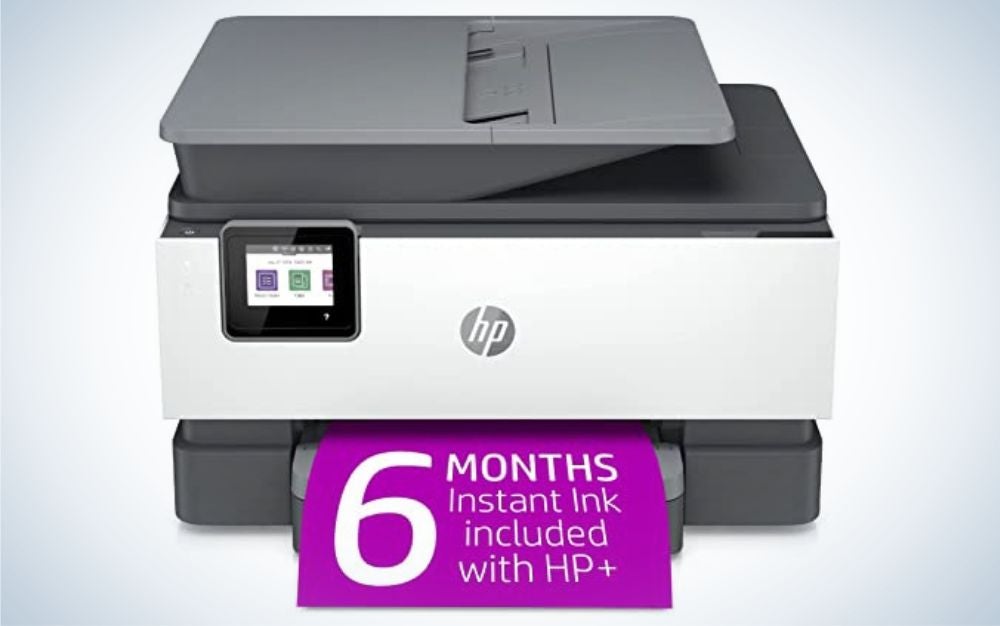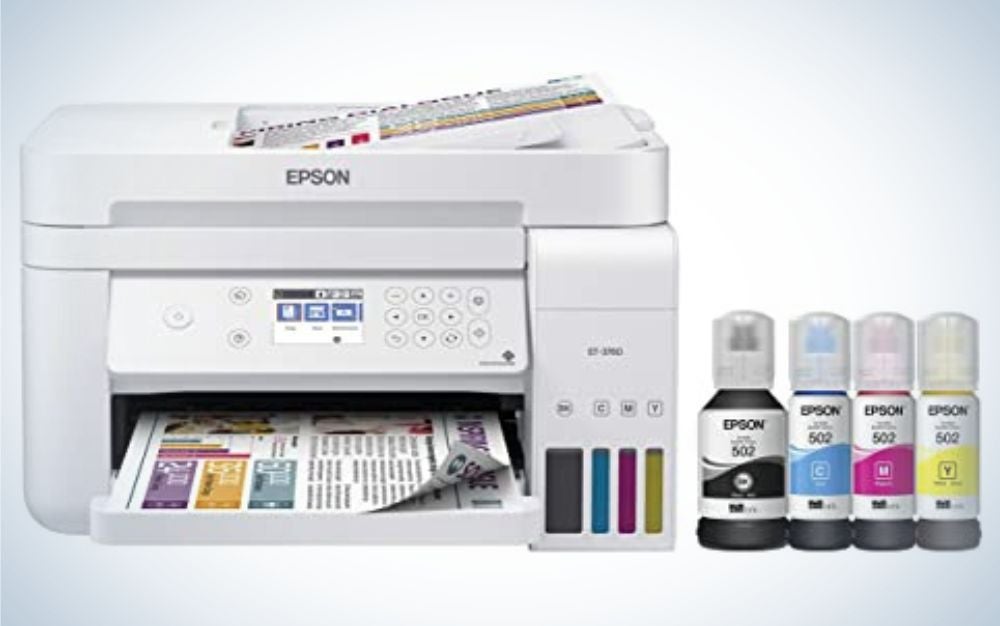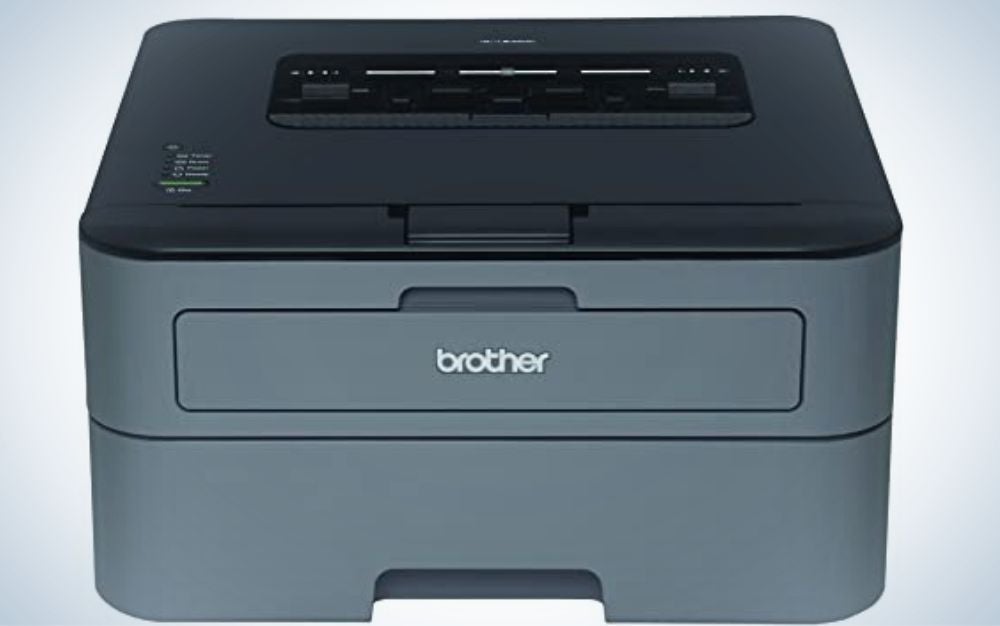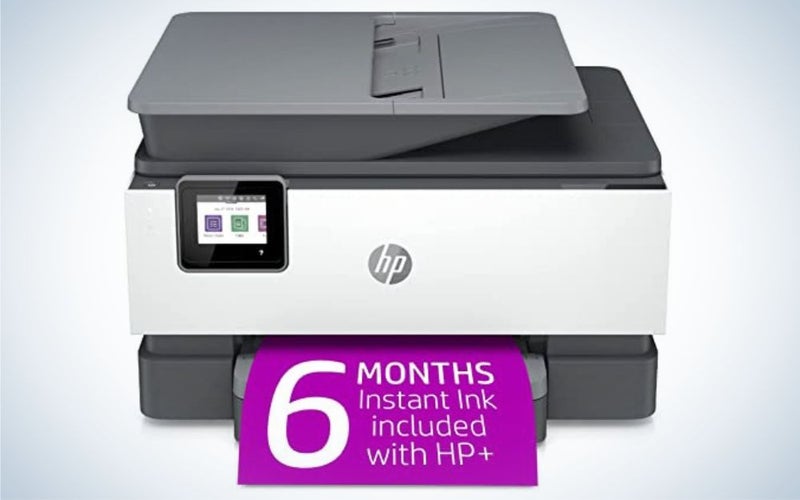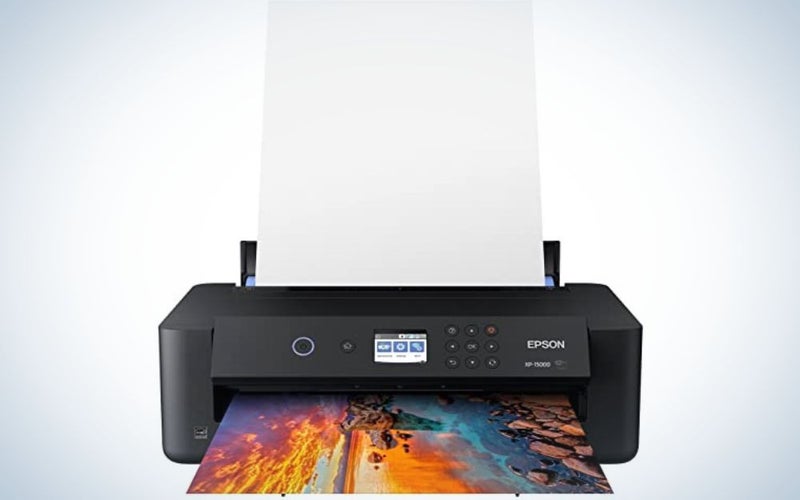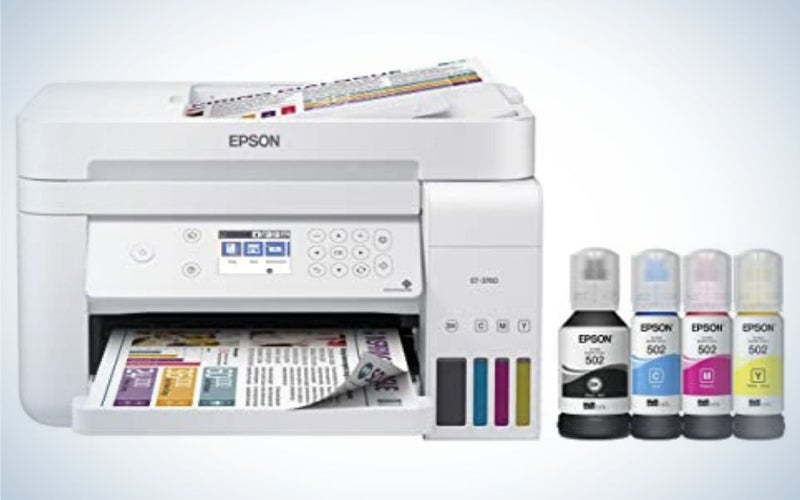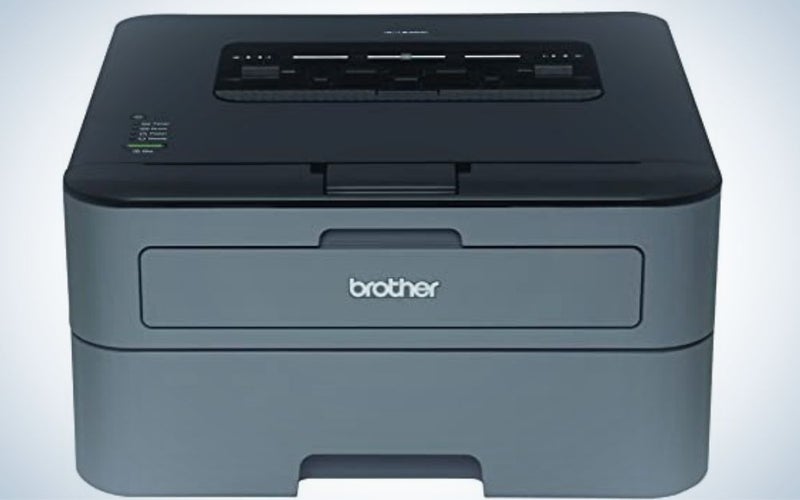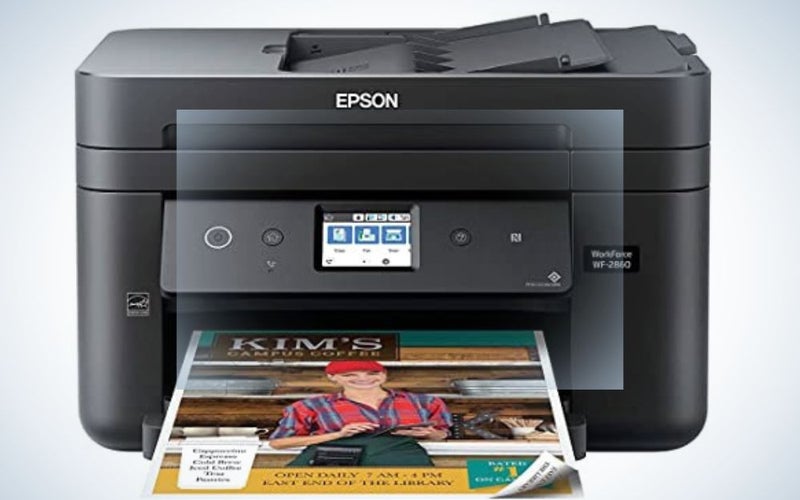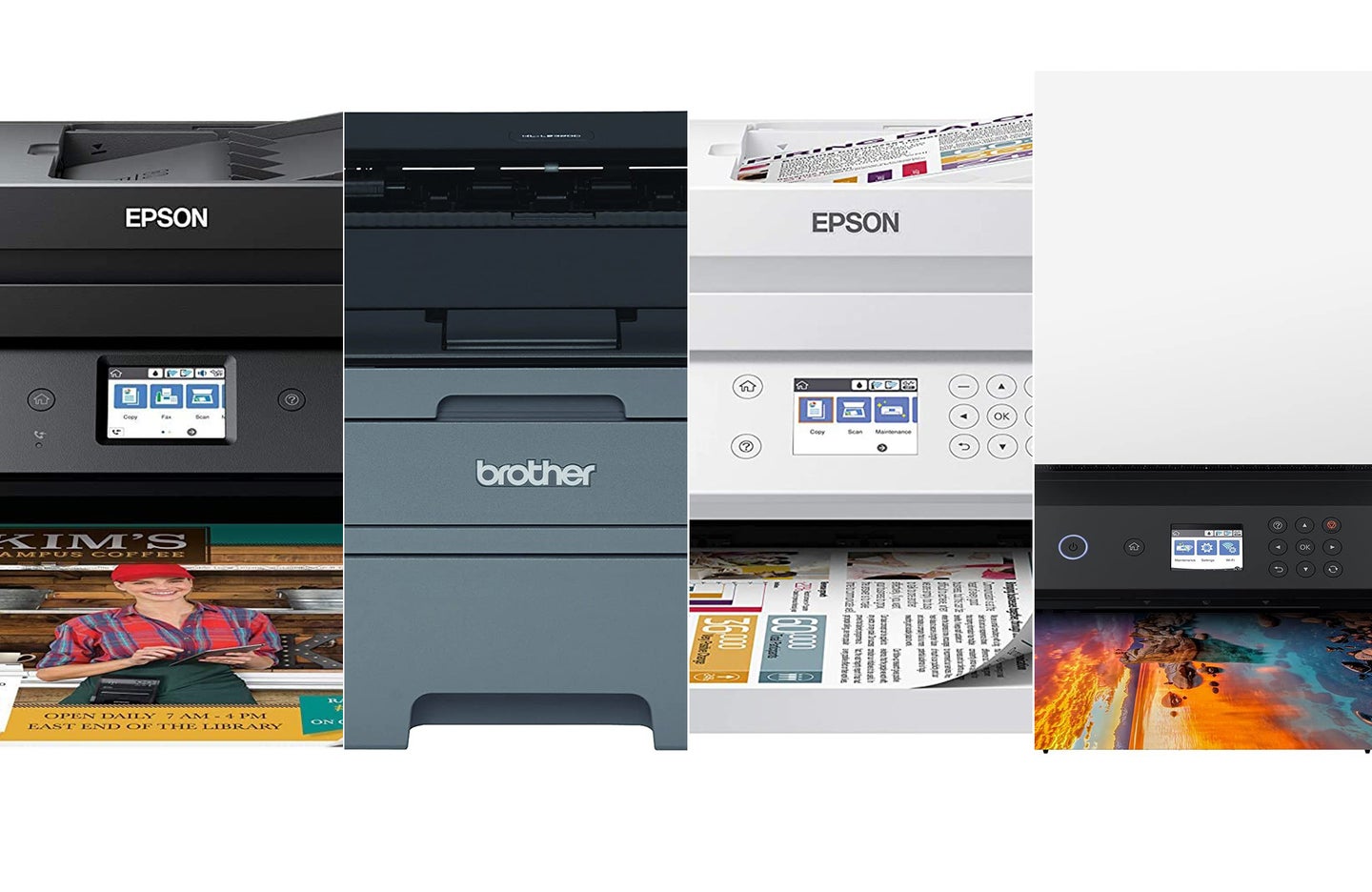
Under your desk or next to your film scanner, the best printers for heat transfers might look like innocuous, simple home printers. That’s because at root they are. These multifaceted printers can bring your graphics and photos to life on all sorts of merchandise and crafts. That includes everything from custom tee-shirts for touring-bands, to middle-school soccer-team logos on coffee mugs. You could even make totes branded with your home botanical-company’s fiddle-leaf-fig logo. However, these printers aren’t purpose built for heat transfers, most are classic office and home printers that will work just as well for printing paper media. Some even feature great perks, like scanners, faxers, and good connectivity options.
The printers we featured in this article can all run heat transfer paper. Heat transfers are simple. Once you have a design, send it to your printer, either an inkjet or laser, which will apply your image onto the coated surface of a sheet of heat transfer paper. This paper is then taped into place on the material you wish to transfer onto, and heated and pressed with a dedicated heat-press device or home iron. The heat will then cause the waxy coating to lift off the paper and bond the image onto the surface (such as a tee shirt). On this list we included one printer that can also run sublimation inks, which use a similar, if slightly different process.
If you’re ready to get busy with photo or graphic printing, read on for the tea on the best printers for heat transfers.
- Best overall: HP OfficeJet Pro 9015e
- Best for professionals: Epson Expression Photo HD XP-15000
- Best sublimation: Epson EcoTank ET-3760
- Best laser: Brother HL-L2320D Mono
- Best budget: Epson Workforce WF-2860
Things to consider when shopping for the best printers for heat transfers
Before you buy your first printer for heat transfers, it’s a good idea to get familiar with what the technology is, how it works, and what’s right for you.
Printer type
As with most home printers, heat transfer printers fall into two basic categories, these are inkjet printers and laser printers. Supertank printers are a subset of inkjet printers. Sublimation printers are usually inkjet printers which are loaded with sublimation inks.
Inkjet printers
The majority of the printers on this list are inkjet printers. These printers use liquid dyes or pigments, which are sprayed onto paper. Often, these printers use four colors, cyan, magenta, yellow, and black (CMYK). However higher grade photo printers will sometimes add extra shades of ink for richer and more specialized hues. Since inkjet printers are relatively straightforward in their design, their initial price is often cheaper than that of a laser printer. However, the dye and pigment inks they use can be very expensive over the long term. Since most inkjet printers don’t heat the paper that they print on, they are more often compatible with heat-transfer papers, and are thus a wider-used choice for heat transfer printing.
Supertank printers
Supertank printers are inkjet printers which use more economical refillable ink wells. They often hold more ink, and use lower cost inks. Many are compatible with the specific inks required for sublimation printing.
Laser printers
Rather than spraying ink onto paper, laser printers use powdered toner. This toner is applied to paper using a laser. Since this toner is a powder, it has the advantage of not drying up. Toner will generally last much longer than ink and generally proves to be more economical in the long term.
Printer transfer paper
Printer paper is generally designed for either laser or inkjet printers and usually is not cross compatible. Remember this when you buy. Paper compatibility also varies substantially by brand. It’s worth being exacting in your research before you buy.
Dye vs pigment
When you’re selecting goodprinters for heat transfers it’s important to consider whether you want a printer that features dye or pigment-based inks. Dye inks are water-soluble, while pigment inks are not. This means that generally dye inks are less color-fast than pigment inks, meaning that the color will fade from these inks with washing more quickly. Dye inks are more common than pigment-inks, and most lower cost inkjet printers use dye-inks exclusively, or use dye-based colored-ink paired with a pigment black-ink. If you want excellent color-fastness and longevity in your inkjet prints, look for a pigment printer, this is especially pertinent for those looking to heat-transfer onto tee-shirts, or other frequently washed garments
Sublimation printers
Sublimation is a different process from heat-transfer printing. Still, the two processes are so similar that it’s a good idea to understand the differences and benefits of both before settling on a printer and process. Sublimation printing uses specific sublimation inks. When heated, these inks turn from a solid into a gas, and then settle back into a solid. This process works best on polyester-fabric and poly-coated surfaces, where the ink transfers to the polyester fiber or poly-coat. Unlike heat-transfer prints, which leave a tangible layer coating your print, sublimation prints do not. Like heat-transfers, sublimation prints do still require a heat transfer device.
Heat press
Whether you’re working with dedicated inkjet heat-transfer paper, laser-print paper, or even a sublimation printer, you’ll need a heat-transfer device. A good option is the TUSY Heat Press Machine. While some basic print transfers will only require a home clothes-iron and ironing board, a dedicated heat press will usually do a better job. These heat presses can cost over $100, and it’s worth factoring this cost into your budget before you buy your printer.
How we chose the best printers for heat transfers
Methodology
We wanted to ensure that our guide to the best printers for heat transfers was as informative as possible. We researched numerous printers from multiple manufacturers and evaluated them based on their ability to print heat transfers. For each, we checked the specs and compared them to leading alternatives, looking at the various inks and papers available for each, and contrasting them to the printers we follow. Along the way a few criterias stood out as most pertinent:
Budget is always a factor when you’re investing in any type of tech. When you’re just starting out with heat-transfer printing the cost of a printer isn’t the only factor, there’s also the heat-transfer device, heat-transfer paper, materials to print on, and inks. Because there’s so much to buy we made sure to pick out solid printers that are as economical as possible. We noted our justifications for our pricier picks. It’s also important to remember that some printers which might be cheaper up front will cost more in the long run, and vice-versa. When you’re shopping for printers it’s especially important to consider operational costs.
Print speed, which is usually notated as PPM (pages per minute) is a factor for those who are looking to scale their print operation. We highlighted the speed of all our picks.
Printer type and pertinent print-method says a lot about the quality of print you’ll get from your heat-transfer, such as its color-fastness, material-type, and more. We included numerous inkjet printers on this list as well as one laser printer, and one supertank sublimation printer.
Features can make or break a printer. Some of the printers on this list are versatile enough for daily office or home use, while still doing a great job with heat-transfer prints. We noted when printers include all-in-one feature sets that deliver nice perks like scanners, copying, and faxing.
The best printers for heat transfers: Reviews & Recommendations
Best overall: HP OfficeJet Pro 9015e
HP
Why it made the cut: With solid print speeds, easy management and connectivity, and an overall easy-to-use build, this home-office classic is an excellent printer for heat transfers.
Specs:
- Type: Inkjet: pigment
- Approx PPM: 22 black, 18 color
- Connection: Wifi, USB
- Features: Scan, copy, fax, print, duplex print and duplex scan
Pros:
- Versatile for all types of prints and lots of papers
- Good speeds
- Easy connectivity
Cons:
- Some of the Smart Task functionality is buggy
You don’t have to be a technician to get good heat-transfer prints from the HP OfficeJet Pro 9015e. One of the most notable home inkjets out right now, the 9015e uses water-resistant pigment inks, and will do just as well for heat transfers as it will for the myriad other tasks you’d expect from a home printer. Featuring a speedy 22 pages a minute with black ink, and 18 with color, this printer will also pump your heat transfers out in no time, so you can move on to production.
With easy Wifi connectivity and Airprint, the 9015e works with your tablets, phones, and Mac devices, just as well as your Windows PC, meaning you can bounce your illustrations or logos out of your Procreate iPad session, and print them on heat transfer paper without a hitch. The all-in-one feature set, which includes fax, copy, and scan, is also a great feature for a heat-transfer printer, as it allows you to easily scan designs.
All in all, the 9015e is a standout printer for heat transfers thanks to its pigment ink support, quick printing speeds, all-in-one feature set, and good connectivity.
Best for professionals: Epson Expression Photo HD XP-15000
Epson
Why it made the cut: Using premium pigment inks that won’t run in the wash, this photo printer is great for heat-transfer media, and also includes great art-focused features like large-media borderless printing, 2-sided printing, and good connectivity.
Specs:
- Type: Inkjet: pigment
- Approx PPM: 9 ppm
- Connection: Wifi, ethernet
- Features: Borderless printing, 2-sided printing
Pros:
- Beautiful photo prints
- Does a great job with heat-transfer media
- Can be used for screen-print media
- Borderless prints are nice
Cons:
- Can streak
- Requires a good bit of maintenance and printer head cleaning
- Expensive ink
This one’s for the photographers and illustrators. The Epson Expression Photo HD XP-15000 is a powerful printer for art studios and print shops. Billed as a photo printer, its high-grade pigment inks will work just as well for your illustrations, drawings, and graphics, and won’t bleed in the wash.
The XP-15000 is a true multimedia printer. It offers a roomy 13″ X 19″ max print size with borderless printing, and auto-duplex (two sided). It does a great job with heat transfer paper. Some have even had luck running the printer with technically-unsupported sublimation inks, however, we don’t necessarily recommend this, as we haven’t tried it ourselves, and it is not suggested by Epson. The XP-15000 should only be used with aftermarket sublimation ink-cartons with caution and research, as it might void the warranty, and might break your machine.
The XP-15000 comes with impressive graphic delivery, but that comes with a cost. The system’s premium pigment ink is expensive, and these inks also do have a propensity for streaking and running, especially on more challenging media. The printer will also require somewhat more maintenance than some, needing occasional cleaning of the printer-heads and nozzles. Still, with brilliant prints, and lots of paper media at your finger-tips, the XP-15000 will make itself useful to your studio practice even when you’re not using it for heat transfers.
Best sublimation: Epson EcoTank ET-3760
Epson
Why it made the cut: With refillable ink-wells, this versatile supertank printer is capable of dazzling photo prints, and runs on sublimation inks well.
Specs:
- Type: Inkjet: dye, sublimation
- Approx PPM: 15 black, 8 color
- Connection: Wifi, Airprint, USB, ethernet
- Features: Scan, copy
Pros:
- Does a good job with sublimation inks
- Good photo quality
- Refillable ink wells save money over the long term
- Good connectivity
Cons:
- No touch screen, controls can be unintuitive
- No scan to USB
We gotta give it up for supertank printers, and the Epson EcoTank ET-3760 is one of the best and most accessible on today’s market. This printer is modern, with great Airprint and Wifi connectivity, a solid scanner, and decent speeds. By default it runs on affordable refillable-wells of CMYK dye-ink with a pigment-black, and can print on heat-transfer paper. However, it really shines when it’s converted to sublimation.
Supertanks are known for their cost saving benefits, eschewing the need for pricy printer cartridges, and instead allowing you to simply squirt in replacement ink. However some, such as this ET-3760, can easily be converted into sublimation printers. Simply buy compatible sublimation inks with your printer purchase and load those into the printer’s wells instead of the traditional dye inks, and you’ll be running sublimation prints in no-time. These inks transition from a solid to a gas, and sublimate onto the fabric of tees, becoming solid once more and bonding to the fabric permanently. Many prefer sublimation prints to heat-transfer prints, as sublimation is usually more permanent.
As both a great sublimation printer and heat-transfer printer, there’s a lot to love in the EcoTank. However, its ample connectivity options do come with some difficulties. Focusing on Airprint and Wifi, the printer can require some troubleshooting on trickier connections, and doesn’t offer easy USB fallbacks like a scan to USB function. It will require more troubleshooting than simpler devices. Still, its benefits easily make up for this, and all-in-all it’s a great buy.
Best laser: Brother HL-L2320D Mono
Brother
Why it made the cut: This mono laser printer pumps out volumes of prints at high speeds, making it a great choice for those working in black and white graphics.
Specs:
- Type: Laser: toner
- Approx PPM: 30 mono
- Connection: USB only
- Features: Duplex printing
Pros:
- Cheap
- Very fast printing
- Crisp black print designs
Cons:
- Only prints black
- No scanner, and no wifi connections
Sometimes basic is best. The Brother HL-L2320D Mono is a heat-transfer printer that shines for its simplicity. This super-fast mono-laser printer is a solid option for those working in black-and-white who want a printer that’s affordable both in the long-term and short.
This Brother printer is mono only. For many that might be an immediate turn-off, but for designers who work exclusively in logos and text, it has its applications. With speeds of up to 30 PPM it’s an extremely fast laser printer that moves paper well. It’s also highly affordable, with a hefty budget starting price point, it will also save money over the long term on refills of black toner.
Without a scanner or Wifi connectivity, and no color, the Brother HL-L2320D is not for everyone. However, what it does, it does very well, and because of this it’s one of the best value options out there.
Best budget: Epson Workforce WF-2860
Why it made the cut: This affordably priced inkjet does a decent job with all the printer basics, and runs heat-transfer paper elegantly, even if it will only allow for dye inks.
Specs:
- Type: Inkjet: dye
- Approx PPM: 14 black, 7 color
- Connection: 2.4GHz WIFI
- Features: Scan, copy, fax
Pros:
- Cheap
- Decent speeds
- All-in-one features include scan and fax
Cons:
- Ink runs out quickly and is expensive
- Connection issues and runs best on 2.4GHz Wifi
If you’re after a budget device that will take care of your heat-transfer needs, the Epson Workforce WF-2860 will check those boxes all day. The dye-based ink delivers decent image quality that’s easy to transfer to handbags, coffee cups, and canvas.
The Epson Workforce is an all in one printer that includes scanning, copying, and faxing in its repertoire, and connects via 2.4GHz Wifi and ethernet. It prints at decent speeds, pumping out up to 14 pages a minute of black prints, and seven colored. As an office printer, you’ll love the Workforce’s wide range of functions, even when you’re not printing heat-press designs.
The printer does have come with a few issues. The Workforce’s dye inks are expensive, and the replacements tend to run out quite quickly. Dye inks also aren’t as color-fast as pigment inks. However, though the machine technically requires Epson Genuine Cartridges, you may be able to get away with off-brand replacements. The printer also has some issues with connectivity, requiring 2.4GHz Wifi, and having issues on 5G connections.
This budget pick is worth it for those looking for a printer for occasional heat-transfers, and who also want the nice extra features that are included: like a scanner and fax. The savings it affords might not be worth it for those looking to rely on this printer for a business.
FAQs
Q: How much do printers for heat transfers cost?
Printers for heat transfers can cost as little as about $100 dollars, and as much as over a thousand. Most users won’t need to spend more than $500 dollars though. That’s why all the printers on our list focus on the $100 – $500 price range.
Q: Is inkjet or laser better for heat transfers?
Generally, inkjet is better than laser for heat transfers, as inkjet printers equipped with pigment inks usually create the best color-fastness.
Q: Do you need special ink for heat transfer paper?
You don’t need a special ink for most heat transfer paper. However pigment inks are more color-fast than dye inks and prints made with pigment inks will last longer.
Q: What is the difference between heat transfer vinyl and heat transfer paper?
Heat transfer vinyl is a printable plastic that can be heat transferred onto surfaces. Printing on heat transfer vinyl requires an expensive wide-format printer that’s usually capable of printing with Solvent, Eco-solvent, or Latex inks. Heat transfer paper on the other hand is a type of paper that works with standard inkjet and laser printers, and accepts the regular pigment, dye, and toner inks they use. Heat transfer vinyl requires a much larger initial investment than heat transfer paper, and can’t be used on the same standard printers you would use with heat transfer paper.
Final Thoughts
Skip outsourcing your tee-shirt prints to online services. With the best printers for heat transfers, you’ll be making great custom gear and crafts in your space. These printers enable you to print your designs onto heat-transfer paper, and then press them onto shirts, mugs, totes, and more. Check out the Epson EcoTank ET-3760 if you’re looking for a decent supertank heat-transfer printer that can also convert to a sublimation printer. If you want to get your feet wet with heat transfer printing but can’t spend hundreds, the Epson Workforce WF-2860 is a good pick that runs decent dye-based prints on transfer paper, and also features a scanner. Finally, the HP OfficeJet Pro 9015e has the most well-rounded feature set for heat-transfers out there, printing vibrant color-fast pigment-ink, with easy connectivity, and a scanner and faxer built right in. When you make your printer selection, don’t forget to pick up a great heat press machine as well, like the TUSY Heat Press Machine.
The post Best printers for heat transfers of 2022 appeared first on Popular Photography.
